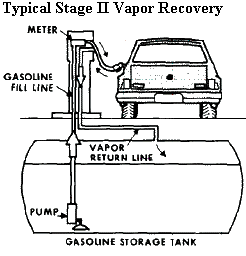Gasoline vapor recovery systems are categorized under two stages. Stage I gasoline vapor recovery systems capture vapors expelled from underground storage tanks at gas stations when being refilled by tank trucks. Stage II systems capture gasoline vapors that would otherwise be vented during individual vehicle refueling at gas stations. Stage I and stage II systems can reduce air pollution, save money by conserving gasoline that would be lost into the air and protect public health by reducing inhalation of toxic gasoline vapors. The effectiveness of the vapor recovery program, and ultimately the quality of the air, depends on correct use and functioning of both stage I and stage II gasoline vapor recovery systems.

Stage II systems include installation of special fuel dispensing nozzles at the pump. Some nozzles have a rubber boot that forms an airtight seal against the vehicle's gasoline filler opening. Other systems use a more convenient "bellow-less" (or "bootless") nozzle. During refueling, vapors are pushed out of the vehicle's gas tank by the incoming fuel. The vapors are then captured by the special nozzle and directed into the underground storage tanks, where they are stored until a bulk delivery is made.
Stage I works in much the same way. Fumes captured and stored by stage II systems during individual vehicle refueling are directed back to the tank truck during refilling of the underground storage tanks. From there, the vapors captured in the tank truck are returned to the bulk-dispensing terminal where they are either recycled or destroyed.
Stage I and Stage II Gasoline Vapor Recovery Systems in Oregon
Most large gasoline storage terminals in Oregon are permitted by DEQ.
In Lane County, LRAPA issues permits for terminals.
Stage I
Stage I controls are required statewide at moderate to large gasoline dispensing facilities:
Most gasoline dispensing facilities are required to obtain a permit from DEQ:
The gasoline dispensing rules require vapor tight recovery systems to prevent vapor loss when transferring gasoline between the bulk storage facility and the delivery vessel (tanker truck), and between the delivery vessel and the storage tank at the gas station.
Stage II
Stage II vapor recovery equipment controls vapors which would normally be emitted during the refueling of motor vehicles at gasoline stations. These controls are only required in the Portland metropolitan area (Multnomah, Clackamas and Washington counties). These facilities are permitted by DEQ (
OAR Chapter 340, Division 242, Sections 0500-0520). The rules were initially adopted in 1991 as part of the Portland-Vancouver AQMA Ozone Attainment and Maintenance Plan, and apply to stations with more than 600,000 gallons of annual gasoline throughput.
The Clean Air Act Amendments of 1990 also required automakers nationwide to equip new vehicles with "onboard refueling vapor recovery" systems (ORVR). This vapor recovery method returns gasoline vapors displaced during refueling back into the vehicle fuel system. The EPA adopted regulations implementing this requirement in 1994. As of 2000, all new light-duty gasoline powered vehicles sold must be equipped with ORVR systems.
As ORVR equipped vehicles permeate the market, stage II vapor recovery systems may become less necessary because the vehicles themselves will recapture the harmful gasoline vapors.